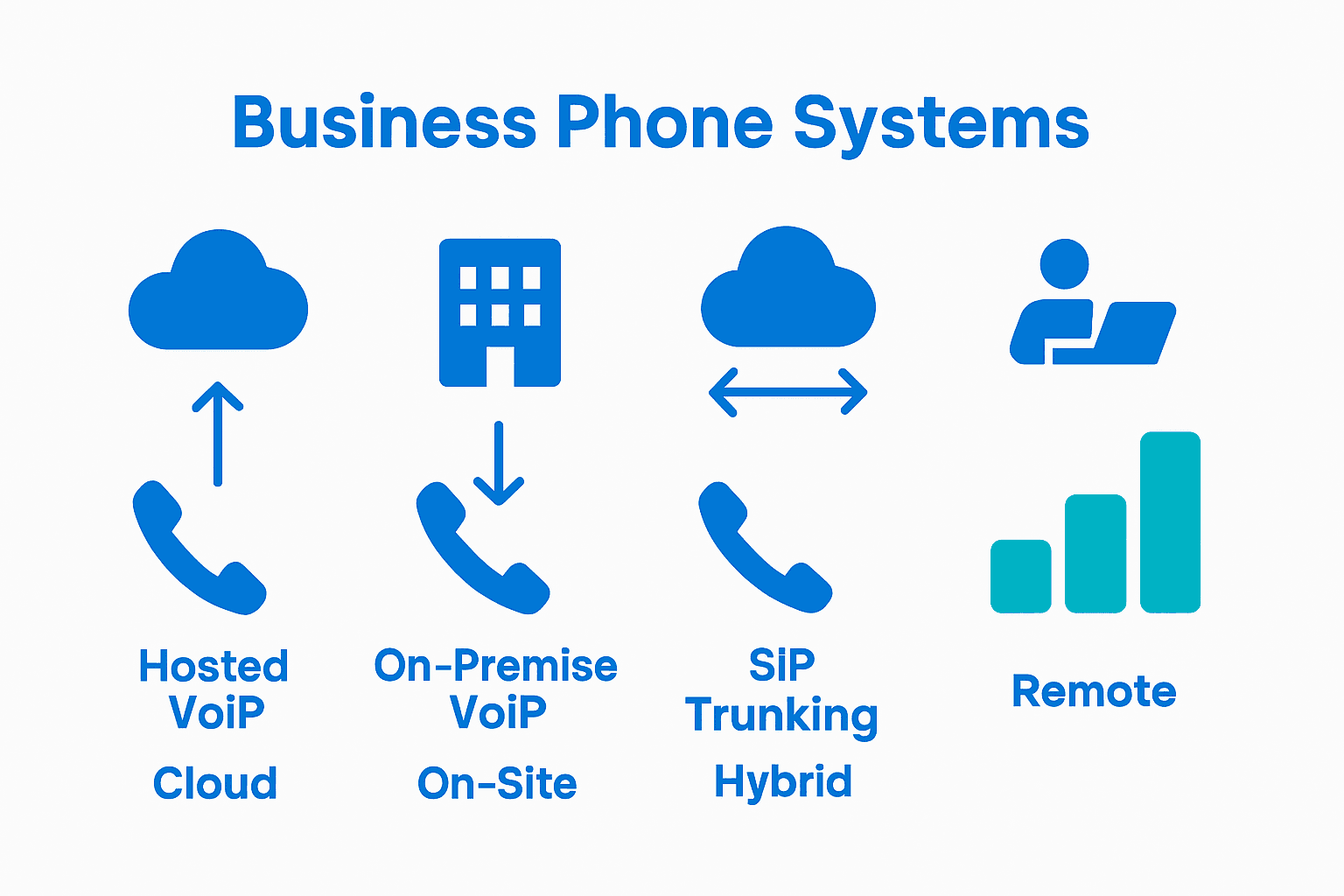Did you know that over 70 percent of businesses now rely on advanced phone systems to handle customer calls and internal communication? As companies grow and embrace remote work, choosing the right communication tools becomes a vital decision that shapes efficiency, professionalism, and client experience. With rapid shifts from old landline setups to feature-packed cloud solutions, discovering what sets these systems apart helps organizations stay ahead in a fast-moving market.
Key Takeaways
| Point | Details |
|---|---|
| Modern Business Phone Systems | They have evolved into comprehensive platforms integrating VoIP technology and advanced features, enhancing communication and productivity. |
| Types of Systems | Organizations can choose from various systems like Hosted VoIP, On-Premise VoIP, SIP Trunking, and Virtual VoIP based on needs and infrastructure. |
| Cost Efficiency | Businesses can significantly reduce communication costs by opting for cloud-based solutions, leading to predictable expenses and scalability. |
| Strategic Selection | Careful evaluation of user requirements, integration capabilities, and future scalability is essential when choosing a business phone system. |
Table of Contents
- Business Phone Systems Defined And Explained
- Types Of Business Phone Systems Compared
- Essential Features And Modern Integrations
- Cost Considerations And Pricing Models
- How To Choose The Right Phone System
- Common Mistakes And Implementation Tips
Business Phone Systems Defined and Explained
A business phone system is a sophisticated communication infrastructure designed to manage multiple telephone lines and provide advanced calling features for organizations. According to the U.S. Chamber of Commerce, these systems have dramatically evolved from simple multiline landline setups to modern, flexible Voice over Internet Protocol (VoIP) technologies that seamlessly integrate with digital workflows.
Modern business phone systems offer comprehensive capabilities that go far beyond traditional telephony. These advanced systems typically include:
- Multiple Line Management: Centralized control of numerous phone lines
- Call Routing: Intelligent distribution of incoming calls
- Extension Networks: Direct internal communication pathways
- Auto Attendant: Automated call handling and directory services
- Voicemail and Messaging: Advanced message capture and distribution
Today’s business phone systems, especially cloud-based solutions, represent more than just communication tools. They are strategic technological platforms that enable businesses to enhance productivity, improve customer interactions, and create more flexible communication environments.

Types of Business Phone Systems Compared
Businesses today have multiple phone system options that cater to different communication needs and technological infrastructures. According to research from the U.S. Chamber of Commerce, modern organizations can choose from several sophisticated communication platforms, each offering unique advantages and capabilities.
The primary types of business phone systems include:
Here’s a comparison of the main types of business phone systems:
| System Type | Deployment Location | Key Advantages | Typical Users |
|---|---|---|---|
| Hosted VoIP | Cloud-based | Minimal hardware High scalability Remote access |
Small to large businesses |
| On-Premise VoIP | On-site | Direct control Custom integration Data privacy |
Midsize to large enterprises |
| SIP Trunking | Hybrid (on-site/cloud) | Connects legacy systems Cost savings Flexibility |
Businesses upgrading legacy systems |
| Virtual VoIP | Virtual/Remote | No hardware needed Mobile-friendly Easy setup |
Startups Small remote teams |
- Hosted VoIP Systems: Cloud-based solutions that provide maximum flexibility and minimal hardware requirements
- On-Premise VoIP Systems: Traditional systems installed directly at the business location with more direct control
- SIP Trunking Systems: Platforms that connect legacy phone systems to internet communication networks
- Virtual VoIP Systems: Flexible solutions that forward calls to existing devices without requiring dedicated hardware
For businesses seeking cutting-edge communication technologies, understanding the differences between VoIP and traditional phones becomes crucial. Each system type presents unique trade-offs in terms of cost, mobility, scalability, and integration capabilities.
Modern businesses must carefully evaluate their specific communication requirements to select the most appropriate phone system that aligns with their operational goals and technological infrastructure.
Essential Features and Modern Integrations
Modern business phone systems have evolved far beyond simple call routing, incorporating sophisticated features that transform communication strategies. According to research from the U.S. Chamber of Commerce, today’s communication platforms offer a comprehensive suite of tools designed to enhance productivity and streamline organizational workflows.
Key features that define contemporary business phone systems include:
- Voicemail-to-Email/Text: Instant message delivery and transcription
- Mobile Twinning: Seamless call routing across multiple devices
- Automated Attendants: Intelligent call management and routing
- Conference Calling: Advanced multi-participant communication capabilities
- CRM Integrations: Direct connection with customer relationship management platforms
Businesses seeking to optimize their communication infrastructure with cutting-edge VoIP features will find that modern systems offer unprecedented flexibility. These integrated platforms go beyond traditional telephony, providing tools like video conferencing, instant messaging, click-to-call functionality, and presence management that support dynamic, remote, and hybrid work environments. The goal is no longer just communication, but creating a seamless, intelligent network that adapts to your business’s unique operational needs.
Cost Considerations and Pricing Models
Business phone system pricing has undergone a significant transformation in recent years, moving from traditional high-cost models to more flexible, budget-friendly solutions. According to research from the U.S. Chamber of Commerce, modern businesses can now access sophisticated communication technologies at a fraction of the cost of legacy systems.
The pricing landscape for business phone systems typically breaks down into several key components:
- Upfront Hardware Costs: Traditional PBX systems often require substantial initial investments
- Per-User Subscription Fees: Cloud-based systems offering more predictable monthly expenses
- Feature Add-Ons: Additional capabilities that can be scaled as business needs change
- Implementation and Support Expenses: Ongoing maintenance and technical support considerations
Exploring hosted phone system solutions reveals that cloud-based platforms can dramatically reduce communication expenses. While traditional landline systems might cost $40-$60 per line monthly, modern VoIP solutions start around $15 per user per month, including advanced features. Smart businesses now prioritize total cost of ownership, considering not just direct expenses but also potential productivity gains and operational flexibility that modern communication systems provide.
How to Choose the Right Phone System
Selecting the ideal business phone system requires a strategic approach that goes beyond simple feature comparisons. According to research from the U.S. Chamber of Commerce, organizations must carefully evaluate multiple critical factors to ensure their communication infrastructure meets both current and future business needs.
Key considerations in choosing the right phone system include:
- User Count and Call Volume: Assess your organization’s current and projected communication requirements
- Remote Work Support: Evaluate flexibility for distributed or hybrid workforce models
- Integration Capabilities: Ensure compatibility with existing business software and workflows
- Scalability: Choose a system that can grow with your business
- Budget Constraints: Compare total cost of ownership, not just upfront expenses
When navigating the selection process, understanding how to set up a business phone system becomes crucial. Experts recommend obtaining multiple vendor quotes, requesting free trials, and carefully reviewing customer feedback to validate service quality and support responsiveness. The right communication system should not just handle calls, but serve as a strategic tool that enhances organizational productivity and provides a competitive edge in an increasingly digital business landscape.
Common Mistakes and Implementation Tips
Implementing a new business phone system involves navigating complex technological and operational challenges that can easily derail your communication strategy. According to research from business technology experts, many organizations inadvertently create significant disruptions by overlooking critical implementation considerations.
Common mistakes to avoid during phone system implementation include:
- Inadequate Network Preparation: Failing to assess internet bandwidth and network stability
- Overlooking User Training: Neglecting comprehensive staff education on new system features
- Ignoring Scalability: Selecting a system that cannot adapt to future business growth
- Skipping Comprehensive Testing: Deploying systems without thorough trial and validation
- Underestimating Support Requirements: Not evaluating vendor’s long-term technical support capabilities
Choosing the right VoIP provider over traditional communication methods requires careful planning and strategic approach. Successful implementation demands a holistic view that considers not just technological specifications, but also team adaptability, workflow integration, and potential future communication needs. Smart businesses invest time in understanding their unique requirements and selecting a solution that offers flexibility, robust support, and seamless technological transition.
Ready to Modernize Your Business Communication?
Are you feeling overwhelmed by outdated systems, high costs, or the struggle to support remote teams? If your organization needs a cloud-based business phone system with features like voicemail-to-email, mobile integration, and zero surprise fees, Voipcom is built for you. We address the pain points highlighted in this guide, including complex implementation, network reliability, and the need for scalable solutions that grow with you. Our all-inclusive approach to cloud-based phone systems empowers your business to work smarter and achieve more.
Take charge of your communications infrastructure today. Explore our full suite of solutions and discover how Voipcom can help you simplify setup, reduce costs, and unlock new capabilities. Visit Voipcom now and see why more Arizona and Colorado businesses trust us to support their teams and customers.
Frequently Asked Questions
What is a business phone system?
A business phone system is a communication infrastructure designed to manage multiple telephone lines and provide advanced calling features such as call routing, voicemail, and automated attendants, enabling organizations to enhance productivity.
What are the types of business phone systems available?
The main types of business phone systems include Hosted VoIP, On-Premise VoIP, SIP Trunking, and Virtual VoIP, each offering unique advantages and deployment methods to cater to different business needs.
How do I choose the right business phone system for my organization?
Choosing the right business phone system involves evaluating factors like user count, remote work support, integration capabilities, scalability, and budgeting to ensure that the system meets both current and future communication needs.
What features should I look for in a modern business phone system?
Key features to look for in a modern business phone system include voicemail-to-email, mobile twinning, automated attendants, conference calling, and CRM integrations to enhance communication strategies and streamline organizational workflows.




